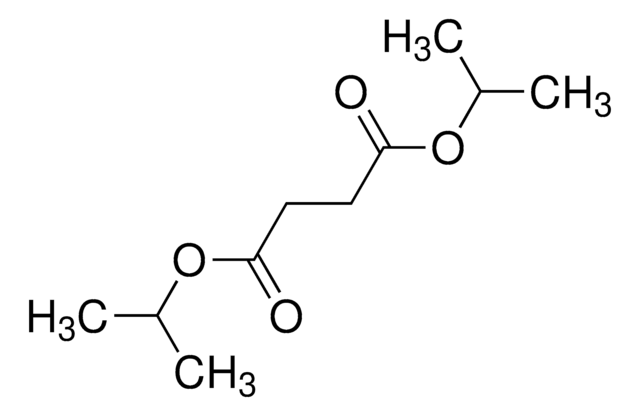W237701
Diethylsuccinat
≥99%, FCC, FG
Synonym(e):
Diethylbutanedioat
About This Item
Empfohlene Produkte
Biologische Quelle
synthetic
Qualitätsniveau
Qualität
FG
Fragrance grade
Halal
Kosher
Agentur
follows IFRA guidelines
meets purity specifications of JECFA
Einhaltung gesetzlicher Vorschriften
EU Regulation 1223/2009
EU Regulation 1334/2008 & 178/2002
FCC
FDA 21 CFR 117
FDA 21 CFR 172.515
Dampfdichte
6 (vs air)
Assay
≥99%
Brechungsindex
n20/D 1.42 (lit.)
bp
218 °C (lit.)
mp (Schmelzpunkt)
−20 °C (lit.)
Dichte
1.047 g/mL at 25 °C (lit.)
Anwendung(en)
flavors and fragrances
Dokumentation
see Safety & Documentation for available documents
Nahrungsmittelallergen
no known allergens
Allergener Duftstoff
no known allergens
Organoleptisch
apple; grape; fruity; waxy; floral
SMILES String
CCOC(=O)CCC(=O)OCC
InChI
1S/C8H14O4/c1-3-11-7(9)5-6-8(10)12-4-2/h3-6H2,1-2H3
InChIKey
DKMROQRQHGEIOW-UHFFFAOYSA-N
Suchen Sie nach ähnlichen Produkten? Aufrufen Leitfaden zum Produktvergleich
Allgemeine Beschreibung
Anwendung
- Impact of indigenous Oenococcus oeni and Lactiplantibacillus plantarum species co-culture on Cabernet Sauvignon wine malolactic fermentation: Kinetic parameters, color, and aroma.: This study explores the co-culture fermentation process in Cabernet Sauvignon wine, focusing on kinetic parameters, color, and aroma. Diethyl succinate was analyzed among the volatile compounds, contributing to the wine′s aroma profile. (Zhang et al., 2024).
- Enhancement of ester biosynthesis in blueberry wines through co-fermentation via cell-cell contact between Torulaspora delbrueckii and Saccharomyces cerevisiae.: The research investigates the role of cell-cell contact in ester biosynthesis during the co-fermentation of blueberry wines. Diethyl succinate is one of the key esters produced, enhancing the aroma and flavor profile of the wine. (Wang et al., 2024).
- Enhancing blueberry wine aroma: Insights from cultivar selection and berry sorting.: This article examines how different blueberry cultivars and sorting methods impact the aroma of blueberry wine, with a focus on the production of aromatic esters such as diethyl succinate. (Wang et al., 2023).
- Comparative analysis of microbial communities and volatile flavor components in the brewing of Hongqu rice wines fermented with different starters.: The study provides a comparative analysis of microbial communities and their impact on volatile flavor components, including diethyl succinate, in Hongqu rice wines fermented with different starters. (Chen et al., 2023).
- Update to RIFM fragrance ingredient safety assessment, diethyl succinate, CAS Registry Number 123-25-1.: This update focuses on the safety assessment of diethyl succinate as a fragrance ingredient, providing comprehensive toxicological data and usage guidelines. (Api et al., 2023).
Biochem./physiol. Wirkung
Lagerklassenschlüssel
10 - Combustible liquids
WGK
WGK 2
Flammpunkt (°F)
208.4 °F - closed cup
Flammpunkt (°C)
98 °C - closed cup
Persönliche Schutzausrüstung
Eyeshields, Gloves, multi-purpose combination respirator cartridge (US)
Analysenzertifikate (COA)
Suchen Sie nach Analysenzertifikate (COA), indem Sie die Lot-/Chargennummer des Produkts eingeben. Lot- und Chargennummern sind auf dem Produktetikett hinter den Wörtern ‘Lot’ oder ‘Batch’ (Lot oder Charge) zu finden.
Besitzen Sie dieses Produkt bereits?
In der Dokumentenbibliothek finden Sie die Dokumentation zu den Produkten, die Sie kürzlich erworben haben.
Kunden haben sich ebenfalls angesehen
Unser Team von Wissenschaftlern verfügt über Erfahrung in allen Forschungsbereichen einschließlich Life Science, Materialwissenschaften, chemischer Synthese, Chromatographie, Analytik und vielen mehr..
Setzen Sie sich mit dem technischen Dienst in Verbindung.













